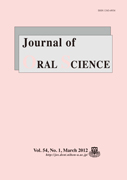Volume 56, Issue 4
December
Displaying 1-12 of 12 articles from this issue
- |<
- <
- 1
- >
- >|
Original
-
2014 Volume 56 Issue 4 Pages 239-243
Published: 2014
Released on J-STAGE: December 12, 2014
Download PDF (819K) -
2014 Volume 56 Issue 4 Pages 245-251
Published: 2014
Released on J-STAGE: December 12, 2014
Download PDF (772K) -
2014 Volume 56 Issue 4 Pages 253-260
Published: 2014
Released on J-STAGE: December 12, 2014
Download PDF (1015K) -
2014 Volume 56 Issue 4 Pages 261-268
Published: 2014
Released on J-STAGE: December 12, 2014
Download PDF (1087K) -
2014 Volume 56 Issue 4 Pages 269-275
Published: 2014
Released on J-STAGE: December 12, 2014
Download PDF (982K) -
2014 Volume 56 Issue 4 Pages 277-285
Published: 2014
Released on J-STAGE: December 12, 2014
Download PDF (859K) -
2014 Volume 56 Issue 4 Pages 287-293
Published: 2014
Released on J-STAGE: December 12, 2014
Download PDF (1055K) -
2014 Volume 56 Issue 4 Pages 295-302
Published: 2014
Released on J-STAGE: December 12, 2014
Download PDF (799K)
Case Report
-
2014 Volume 56 Issue 4 Pages 303-306
Published: 2014
Released on J-STAGE: December 12, 2014
Download PDF (1037K) -
2014 Volume 56 Issue 4 Pages 307-310
Published: 2014
Released on J-STAGE: December 12, 2014
Download PDF (1147K) -
2014 Volume 56 Issue 4 Pages 311-314
Published: 2014
Released on J-STAGE: December 12, 2014
Download PDF (993K) -
2014 Volume 56 Issue 4 Pages 315-318
Published: 2014
Released on J-STAGE: December 12, 2014
Download PDF (943K)
- |<
- <
- 1
- >
- >|
